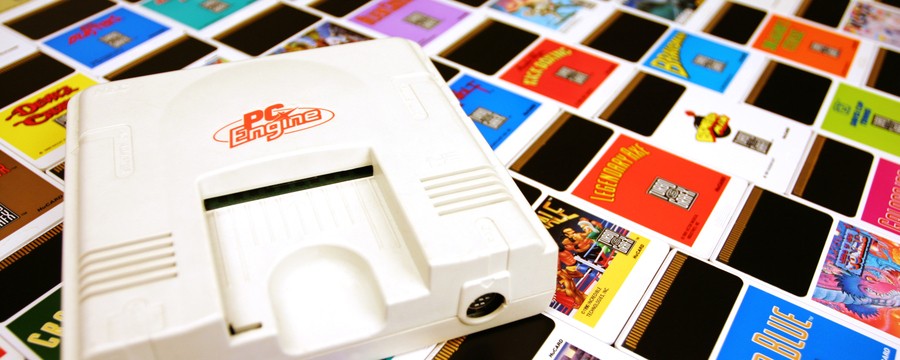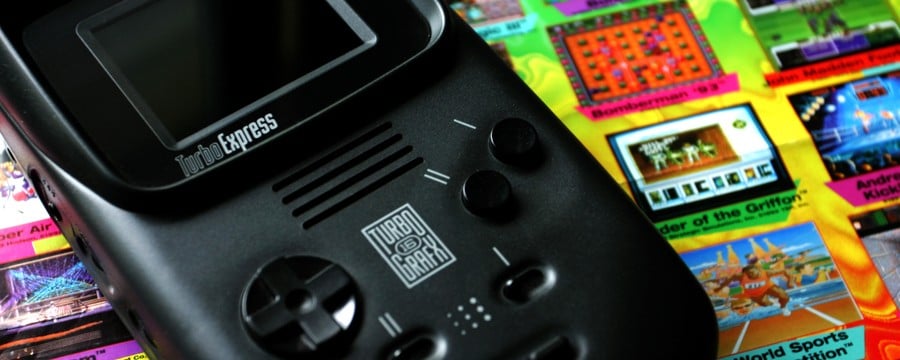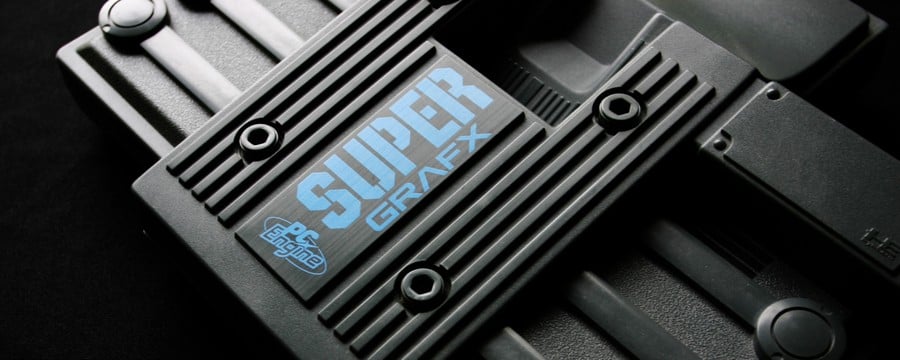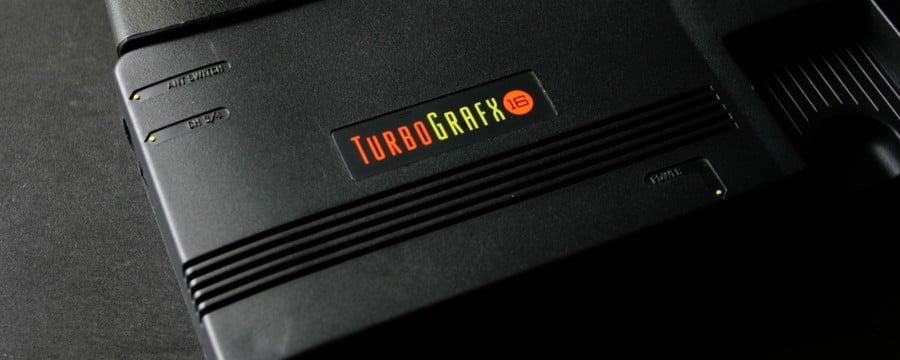
This piece was originally published in 2012. With the news that Konami is producing a PC Engine Mini, we thought you might like a fresh look. Enjoy!
Western gamers tend to consider Nintendo and Sega as the two major players in the 16-bit war. On European and American soil this was certainly the case - the Super Nintendo and Mega Drive (Genesis to North American players) battled it out for supremacy, selling millions of units and making their creators household names in the process. The story was ever so slightly different in Japan, however. Nintendo remained amazingly successful but it was NEC’s PC Engine that emerged as their main rival, leaving the unfortunate Sega to make do with a disappointing third. Remarkably, this popular Japanese console struggled in the US and bypassed Europe altogether. Unravelling the complex lineage of this intriguing system isn't straightforward thanks to numerous hardware amendments, name changes and add-on enhancements – not to mention the involvement of three different parent companies - but by thunder, we’re going to try.
This highly promising union would result in one of the most successful and influential Japanese consoles of all time
Back in the late ‘80s many companies - both inside and outside the video game industry - observed the runaway success of Nintendo’s NES/Famicom with mounting envy. One such corporation was Japanese electronics giant Nippon Electric Company, more commonly known as ‘NEC’. Established at the turn of the 20th century to produce telephone components, NEC had gone on to become one of the world’s leading computer manufacturers. A new conquest was beckoning in the form of the lucrative console market and while NEC undoubtedly had the financial clout to enter this arena, it lacked vital industry experience. Approaches were made to several leading video game studios for support and it was soon discovered that Hudson Soft - the first developer to obtain a license to develop for the Nintendo Famicom – also happened to be tentatively exploring the possibilities of producing its own system.
Founded by brothers Yuji and Hiroshi Kudo in 1973, Hudson didn't start out in the field of interactive entertainment. “They originally began by selling telecommunication devices and some art photographs,” comments John Greiner, former President of Hudson Entertainment in the US and now the head man at MonkeyPaw Games. “Within two years they began selling computer related products and soon afterwards, the company started to make games. In fact, they were the first to publish a PC game in Japan.” Hudson had created the high-powered ‘LSI’ chipset but didn't possess the necessary cash to enter the console race alone. “They realized they needed a partner to manufacture and market to a large base," explains Greiner. "Fortuitous timing landed NEC as a company that was interested in entering the console market.” This highly promising union would result in one of the most successful and influential Japanese consoles of all time.
Small is Beautiful
In terms of pure aesthetics, the PC Engine must surely rank as one of the most iconic designs in the history of electronic entertainment. The original white system was petite and attractive, making rival consoles look positively ugly in comparison. “Hudson and NEC wanted to create a system that was appealing in design,” Greiner says. “The previous generation of consoles felt more like toys, so they wanted to create a system that was sleek yet powerful.” With dimensions of 135 x 130 x 35mm, it remains the smallest home console ever made. This appeal was further augmented by the unique delivery system for software, as Greiner recalls: “The PC Engine used a unique chip-on-board media instead of cartridges. These credit card sized ‘HuCards’, or ‘Turbochips’ as they were called in America, were marvels in design. They were extremely durable, portable and cool.”
The slender size of the machine belied the impressive technical specifications contained within. The custom-built dual 16-bit graphics processors (HuC6260 and HuC6270A) allowed the PC Engine to display stunning arcade-quality visuals. Remarkably, the unique HuC6280A CPU that powered this minuscule wonder was 8-bit - a fact that would provoke many playground arguments about whether or not the machine should be classed in the same league as ‘true’ 16-but consoles like the SNES and Mega Drive.

NEC launched the PC Engine in Japan on October 30th 1987 and by the end of the subsequent year, it was the best selling console in the country, dethroning the Famicom in spectacular fashion. One of the key reasons for this triumph was impressive third-party support, which previous consoles like Sega’s Mark III (known as the Master System in the West) had struggled with, largely thanks to Nintendo’s stranglehold over software developers. Striking technical specifications combined with the rampant enthusiasm shown by NEC and Hudson – two highly respected companies in Japan – encouraged many developers to support the console. Namco, Irem, Masaya, Konami and Human all flocked to the PC Engine banner, bringing some of their most treasured franchises with them. Amazingly, permission was also secured to port several highly esteemed Sega coin-ops, including Afterburner 2, Power Drift, Space Harrier, Outrun, Wonderboy III and Fantasy Zone. These were proficiently reprogrammed by internal studio NEC Avenue (later known as ‘NEC Interchannel’, and more recently ‘Interchannel-Holon’, as the company is no longer affiliated with NEC) and ironically they frequently outclassed Sega’s own efforts on the Mega Drive.
NEC and Hudson were driven by what a CD could bring to gaming: amazing sounds, robust animation, and seemingly unlimited storage space
With a successful launch out of the way, NEC soon set about creating what would be the first of many hardware updates - the ‘CD-ROM2’ add-on. “At the time, publishers were constrained by the cost and memory of carts,” Greiner remembers. Released in 1988, it came with a fetching briefcase-style set-up and remains one of the most desirable pieces of PC Engine paraphernalia. Early CD software was hampered by lack of RAM but this was thankfully rectified via a series of ‘System Card’ updates (which came in HuCard form and granted more usable memory). This, in turn, gave birth to the renowned ‘Super CD’ criterion, which allowed programmers to be more flamboyant and really put that additional CD storage space to meaningful use. “NEC and Hudson were driven by what a CD could bring to gaming: amazing sounds, robust animation, and seemingly unlimited storage space,” confirms Greiner.
Commitment to largely unproven CD-ROM technology showed that NEC intended to remain on the cutting edge, but in 1989 this burning desire to innovate resulted in a near-fatal error of judgement. Despite the runaway success of the PC Engine, Nintendo’s Famicom remained the console to beat and when solid information regarding the specifications of its successor began to surface in the Japanese press, NEC panicked. They rashly decided to launch a new console and the SuperGrafx was born. Essentially a PC Engine with additional graphics chips and four times as much RAM, this bulky machine was handicapped by the fact that it utilized the same 8-bit CPU as its older stablemate. Coordinating the extra chips created a massive drain on processing power and developers struggled to achieve satisfying results.

Incredibly, only five dedicated games ever saw the light of day (a ‘hybrid’ version of Darius Plus was also released that would also play on a standard PC Engine). Thanks to an impressive conversion of Capcom’s Daimakaimura (Ghouls ‘n’ Ghosts) and excellent overall compatibility (it is able to play HuCard games and can be connected to the CD-ROM drive, making it the only machine in the PC Engine dynasty with the potential to play all available software), the SuperGrafx remains a highly sought-after collector’s item, regardless of its abject commercial failure.
Go West
In spite of this slight hiccup, success was virtually assured on home soil. With proven technology and a library of excellent games, it made perfect sense to unleash the console Stateside, as Greiner recalls: “The US market was stirred into a fevered state by fans wanting a true gaming upgrade from the 8-bit era.” NEC’s American arm rechristened it ‘TurboGrafx-16’ and the external casing of diminutive console was retooled in order to make it look more substantial and imposing. Nevertheless, the fortunes of the TurboGrafx-16 stood in stark contrast to that of its Japanese sibling. “The success of the PC Engine was undeniable in Japan, where at one point it captured nearly a third of the market,” states Greiner. “In the US however, it was a different story.” Sega released the Mega Drive (Genesis) in North America at almost exactly the same time and began relentlessly and ruthlessly marketing their new console. “Sega were hard-hitting, gaining an irreverent edge which best suited the US demographics,” explains Greiner. The early promotions were extraordinarily successful and the selection of available software - which not only included some of Sega’s key arcade titles but was also more tailored to a Western audience – gave it the edge. NEC’s machine was lumbered with a very ‘Eastern’ assortment of games and Hudson struggled to craft titles that would appeal to US players. “It was a tremendous challenge launching so many games in such a short time frame,” remembers Greiner. “That is why you initially saw so many games that were ported from Japan and from genres that were most popular in that country, like shooters.”
Marketing and understanding the US gamer mentality was always a challenge for NEC
Nintendo’s dominance over third-party developers became apparent once again with American software companies being just as fearful of Nintendo’s wrath as their Japanese counterparts. “Unfortunately, while Hudson created many great games for the system initially, it still wasn't enough. Many of the big name brands from other publishers simply couldn't be published,” states Greiner. In a similar situation to that witnessed in Japan, Nintendo stipulated that if a third party game was produced for the NES, it couldn't be released on a rival console. “That became a challenge that was not easily overcome,” Greiner reflects, mournfully. Nintendo’s bullying tactics were later found to be illegitimate but by then it was too late. To make matters worse, NEC vastly over-produced their hardware. “They listened closely to retailers, who were very aggressive in their belief that 16-bit gaming was going to be a big success,” explains Greiner. “NEC therefore over-ordered units and this proved fatal in the long run as they committed tremendous financial resources to create the hardware, which ultimately handcuffed them in marketing spend. Sega were able to successfully steal market share away with a ‘bad-ass’ image and an unfettered marketing bankroll.” The seemingly unbridled success experienced in Japan had sadly eluded NEC in America. “Arguably, the TurboGrafx-16 had better games, but a number of missteps took place when it came to hardware styling, box art, pack-in and release schedule,” comments Greiner. “Marketing and understanding the US gamer mentality was always a challenge for NEC.”

Around this time there were faint rumblings of a European release. Early in 1990 it was revealed that a UK company called ‘Mention’ were intending to sell specially modified machines that would circumvent the various problems UK importers were experiencing. Known as the ‘PC Engine Plus’, this slightly altered system did not have the official blessing of NEC and unsurprisingly never took off. Despite several magazines reporting that NEC themselves were ‘literally months away’ from officially launching the console in the UK for ‘under £100’, it never happened. “Europe was neglected as this was NEC’s first foray into the console market,” comments Greiner. “However, there was considerable grey market penetration as Europeans also wanted to participate in the new gaming revolution”.
The Dynamic Duo
Back in Japan, the amazing success of the freshly-released Super Famicom provoked NEC to consolidate the existing PC Engine hardware in the form of the ‘Duo’ system. As you might expect from the snappy moniker, this was a PC Engine and CD-ROM drive combined. The need for (easily misplaced) System Cards was also negated as the Duo had the necessary RAM built in. Launched in 1991, the machine arguably represented the zenith of the PC Engine brand. A US release followed via the newly founded Hudson/NEC venture ‘Turbo Technologies Incorporated’ (TTI for short), but the re-branded TurboDuo suffered the same ignominious fate as the TurboGrafx-16 before it - despite having some excellent software, it failed to gain a significant market share and faded quickly. Incredibly, it’s since been confirmed by a former TTI employee that the company was offered exclusive home console rights to Midway’s arcade hit Mortal Kombat, but the head office in Japan decreed that fighting games were oversubscribed in the US and neglected the offer.
The success of the Japanese Duo allowed NEC to further strengthen their position, applying intense pressure on Nintendo with a series of excellent titles whilst keeping poor old Sega firmly in third place. Classic games like Dracula X: Rondo of Blood, Gate of Thunder, Star Parodier and Ys proved that even in the relative infancy of the CD-ROM age, the extra space afforded by the format could be put to sterling use. Fortunately, the humble HuCard was not forgotten and a noteworthy conversion of Capcom’s Street Fighter II: Champion Edition pushed the maximum capacity of the credit card-sized format up to a muscular 20 megabits.

1994 saw the introduction of the Japanese-only ‘Arcade Card’, which increased the PC Engine’s power to previously unimaginable levels. Slick coin-op conversions of Fatal Fury Special, World Heroes 2 and Art of Fighting soon appeared and while these incredibly faithful ports won the console a whole new group of admirers, they came too late to make a truly telling impact. The 16-bit party, which the 8-bit PC Engine had skilfully managed to gatecrash, was beginning to wind down and a new wave of powerful 32-bit behemoths loomed ominously on the horizon. Sales started to dwindle, forcing NEC and Hudson to develop a successor – the ill-fated 32-bit PC-FX. Built around the rather misguided belief that FMV-style games represented the future of the console industry, it unsurprisingly flopped at retail.
After nearly a decade of unwavering commitment to one another, NEC and Hudson finally parted company in the middle of the nineties. The former went on to supply the graphical muscle behind Sega’s Dreamcast while the latter continued to produce games for a wide range of consoles, before eventually being purchased by Konami in 2011. A year later - following the closure of the US-based Hudson Entertainment - the Hudson Soft name ceased to exist as the company was absorbed entirely into Konami.
That's not the end of the PC Engine story, however; at E3 this year, it was confirmed that Konami is bringing the brand back from the dead. An entirely new generation of players will get to see what the fuss is all about, and that makes us very happy indeed.
This feature was originally printed in its entirety in Retro Gamer magazine, and is reproduced here with kind permission. Special thanks to Aaron Nanto for providing exclusive hardware photos.





Comments 0
Leave A Comment
Hold on there, you need to login to post a comment...